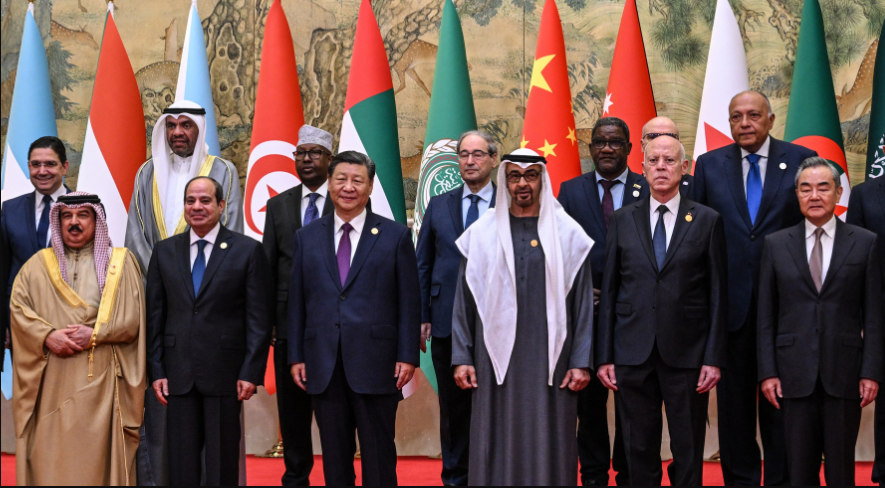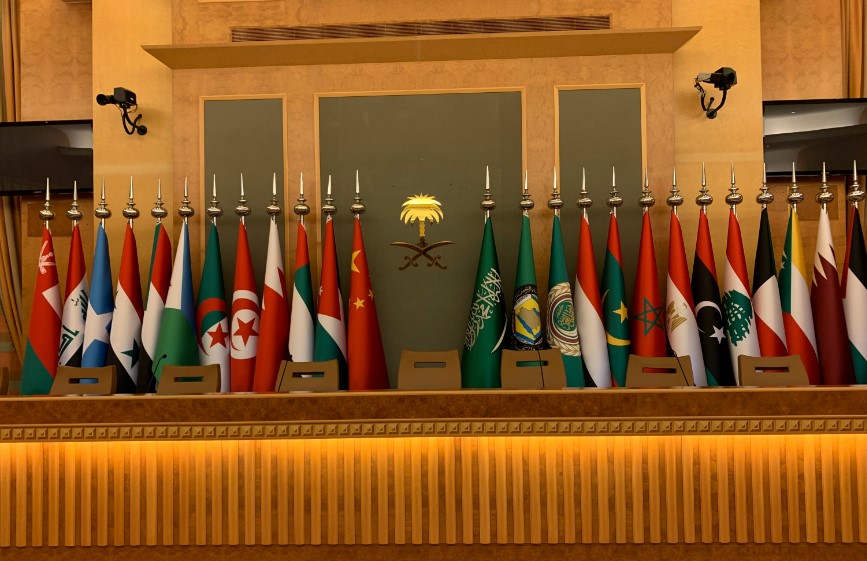
Speaking at the 10th ministerial conference of the China–Arab States Cooperation Forum held on 30 May in Beijing, Xi Jinping hailed a ‘new era’ of Chinese–Arab relations.
Although China’s relations with the Arab Gulf States are expanding and grabbing international headlines, they face a major obstacle. China shuns military alliances, whereas the Arab Gulf States have heavily relied on external security guarantees since their independence. This significant gap in the national strategies of the two sides will prevent the relationship from advancing into higher geopolitical realms, limiting cooperation to secondary areas in an era of shifting power centers. Amidst various ongoing shifts, security matters continue to shape regional geopolitics.
Background
In the post-World War II period, the Arab Gulf States heavily depended on US protection through formal and informal security arrangements. With the exception of Saudi Arabia, the other five members of the Gulf Cooperation Council (GCC), the UAE, Qatar, Kuwait, Oman, and Bahrain, had formal defense agreements with the US. Although Saudi Arabia avoided a formal defense pact, in practice, it nearly totally depended on the US for security throughout the decades. The US role in particular expanded after the British withdrew from the region. Washington developed an all-encompassing engagement with Gulf monarchies. It provided them with security against external threats, established military bases, and deployed service personnel and equipment. The Fifth Fleet of the US Navy established its headquarters in Bahrain, which serves as a strategic hub for naval operations in the entire region. Over the decades, Arab Gulf States have entrenched their national security with the US to such an extent that disentangling from this relationship will be a protracted and difficult process. The US proved its commitment with its actions. The most audacious example was the US’s decisive response to Iraq’s invasion of Kuwait in 1991. The US-led coalition liberated Kuwait within five days of the operation desert storm. This further deepened the Arab Gulf States’s reliance on US security arrangements. Within three years of the war, in 1994, the UAE also signed a comprehensive defense agreement with the US.
This decade-old US-Arab Gulf States relationship, however, began to change during the 2010s. The US’s lukewarm response to the security of these states became the primary reason for this shift. For instance, the US showed a cold response to its allies during the Arab Spring, which toppled several regimes, and against drone attacks by Iran-backed Houthis in the UAE and Saudi Arabia. As a result, the Arab Gulf States sought alternative allies and accelerated their efforts toward domestic arms production. In 2015, Saudi Arabia established the Islamic Military Alliance to Fight Terrorism (IMAFT), apparently to counterterrorism, which was equally driven by Riyadh’s sense of insecurity. The search for security also led the Arab Gulf States to develop relations with China, Russia, India, and other Asian countries during this period.

The US Return to the Region
As the US’s lukewarm response to the security of the Gulf monarchies during the 2010s became the main reason behind their gradual drift away from the US influence, as mentioned above, the US offered greater security incentives to reverse the trend several years later when it decided to reestablish its dominance in the region. As a part of the Abraham Accords (2020), the US approved the sale of its most advanced stealth fighter jet, F-35, to the UAE. In September 2023, the US signed the Comprehensive Security Integration and Prosperity Agreement with Bahrain. In January 2024, the US reached an agreement with Qatar to extend the US military presence at the Al Udeid Air Base in the southwest of Doha. This is the largest US military installation in the Middle East, with the capacity to accommodate over 10,000 US troops. Most significant among these US security-centric incentives for the region is its ongoing negotiations with Saudi Arabia for a comprehensive defense pact. The pact, which is at the final stage of negotiations, according to the top officials of both sides, would provide Saudi Arabia with a security guarantee, access to advanced US weapons, and nuclear and emerging technologies. In return, Riyadh will halt Chinese arms purchases and restrict Beijing’s investment in crucial areas of the Kingdom. The pact will formally bind Saudi Arabia to the US security structure in the region.
Parallel to the Arab Gulf States, the US expanded its military alliances globally. In its latest enlargements, NATO accepted Finland in 2023 and Sweden in 2024, raising the total membership to 32. The US also hinted at further upgrading the defense agreement with Japan that was signed in 1960. In June 2024, the US signed a 10-year Bilateral Security Agreement with Ukraine. In addition to formal ones, the US pushed forward quasi-alliances. In 2017, it resuscitated the Quad, a quadrilateral grouping comprising the US, India, Japan, and Australia. In 2021, the US established AUKUS, a trilateral security partnership involving Australia, the UK, and the US, to assist Australia in acquiring nuclear-powered submarines. The global expansion of US alliances further solidified its perception as a capable security ally in the eyes of the Arab Gulf States.
China’s Perspective on Military Alliances
In contrast to the US’s audacious security arrangements and alliances, China has remained averse to participating in security arrangements, whether collective or bilateral, let alone forming formal alliances. This eschewal started in the early 1980s when the Chinese leadership led by Deng Xiaoping decided to strictly follow a non-alliance policy.
In the 21st century, as China embarked on a great power status coupled with intensifying Sino-US rivalry, it initiated a debate in Chinese academia to rethink non-alliances. These debates resulted in the formation of the Global Security Initiative (GSI), which Xi Jinping first proposed at the Boao Economic Forum in April 2022. The GSI provides a broad view of China’s perspective on international security, emphasizing comprehensive security architecture while respecting sovereignty. Moreover, the GSI makes a ‘strident criticism’ of the US alliances, challenges US leadership, and proposes the Chinese model as an alternative. The GSI also guides China’s security approach to the Arab Gulf States. At his keynote address to the China-GCC meeting in December 2022, Xi Jinping invited regional countries to join the GSI. However, GSI did not receive much attention. Among the Arab Gulf States, only Kuwait expressed its open support for the GSI. Saudi Arabia expressed only “appreciation”; the UAE remained unclear, while Qatar, Bahrain and Oman remained indifferent. One of the reasons behind this lukewarm response was GSI’s strident criticism of US alliances, whereas most Arab Gulf States were US allies. Second, and most importantly, none of the Chinese initiatives addressed the security requirements of the Arab Gulf States. What, then, is the nature of China’s engagement with the region?
Nature of China’s Engagement
China’s engagement with the Arab Gulf States, compared to its role two decades ago, is on the rise. However, Beijing’s overall influence is steady, with a focus on nonconfrontational areas and picking up low-hanging fruits. In the diplomatic arena, China has moved from a cautious to an active role, as manifested in the China-brokered deal that normalized Saudi-Iranian relations in March 2023. This showed that China could mediate between two parties at odds if both agreed. This was an optimal point in China’s diplomacy in the region. However, after Houthis’ attacks on shipping in the Red Sea, it became clear that China would continue to abstain from joining any bilateral or multilateral security arrangement. This dissipated the hype that had emerged after the Saudi-Iranian deal and reiterated Beijing's steadfast non-alliance policy.
In the defense sector, which, along with emerging technologies concerned Western countries, China’s actual engagement is minimal. While China’s establishment of the largest pavilions in the defense show in the UAE and Saudi Arabia created hype, the share of its arms exports to the region remained below single digits, with 2.1% to the UAE and 6.3% to Saudi Arabia. The percentage of Chinese arms exports to other member countries is even lower. For emerging technologies, China initially made progress. Chinese companies Huawei and Alibaba were involved in setting up the 5G network in Saudi Arabia and the UAE, as well as in cloud computing, cybersecurity, smart cities, and other related services. However, as China began to deepen its footprint, the US forced regional countries to restrict their cooperation with China. Under U.S. pressure, King Abdullah University of Science and Technology publicly announced its decision to divest from Chinese technologies. The CEO of Saudi Alat stated that if the U.S. required it, the company would separate from Chinese technology. In April 2024, the UAE’s G42 signed an agreement with Microsoft and decided to phase out Chinese hardware and cut ties with Chinese entities.
China’s currency swap agreements with the Arab Gulf States were also overstated. The total value of China’s currency swap with Saudi Arabia is US$6.9 billion, signed in 2024; with the UAE, US$4.9 billion, signed in 2023; and with Qatar, US$5.7 billion, signed in 2021. These amounts are minimal compared to the volumes of their economies, their two-way trade, and the overall value of China’s currency swaps, with 40 countries worth US$586 billion. Therefore, there is no possibility on the horizon of the so-called petroyuan replacing the petrodollar.
It is important to remember that the broader Middle East, encompassing the Arab Gulf States, is exceedingly volatile and characterized by violent historical and ideological conflicts. China seeks to avoid security involvement in this region, apprehensive that terrorism could potentially spill over onto the mainland.
Moreover, while China is often perceived as embarking on a global expansion, its primary focus remains on maintaining internal stability through sustained economic growth. It is true that this policy is gradually evolving, but there is no indication that China will consider forming security partnerships or military alliances with other countries in the future.
While this limitation prevents China from deepening its partnerships with most countries, it is particularly felt in the Arab Gulf States, which have a historical and structural dependence on external security guarantors. Therefore, China's cooperation with the Arab Gulf States will remain limited to areas such as energy, trade, finance, investments, tourism, a moderate range of emerging technologies, and defense.
There is little likelihood of the two sides expanding their cooperation in higher geopolitical domains. Given the dominant influence of the US in the region, which could further expand if the defense pact with Saudi Arabia is signed, China may face additional challenges in areas that Washington considers threatening to its interests. The US is likely to remain the dominant player in the Arab Gulf States in the future.
